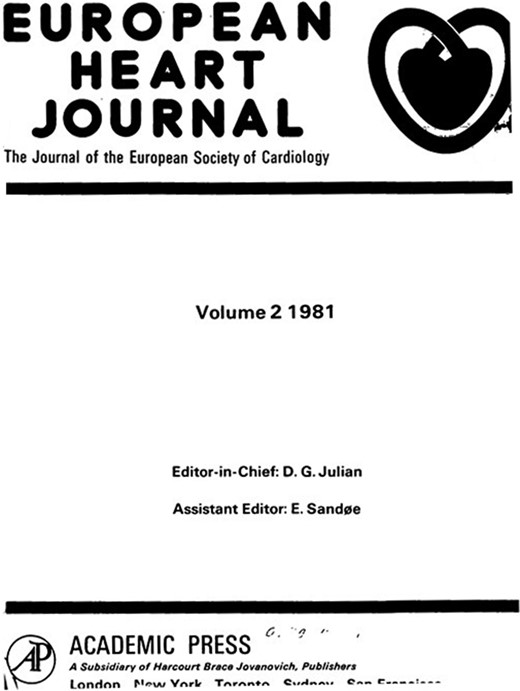-
PDF
- Split View
-
Views
-
Cite
Cite
Judith Ozkan, Remembering Desmond Julian and the first edition of the European Heart Journal, European Heart Journal, Volume 43, Issue 47, 14 December 2022, Pages 4864–4866, https://doi.org/10.1093/eurheartj/ehac592
Close - Share Icon Share
All correspondence relating to this article should be sent to[email protected]
The European Heart Journal (EHJ) has evolved enormously since it was founded as the flagship publication of the European Society of Cardiology (ESC) over 42 years ago. As hits and download statistics show, it now has a broad reach that goes beyond cardiology and Europe. But how did it start and what were its origins? CardioPulse talks to the author of the journal’s first published paper back in February 1980.
The distinction of being the first published EHJ author belongs to Günter Breithardt, MD, Emeritus Professor, and former head of the Department of Cardiovascular Medicine at University Hospital Münster, Germany. His research paper looking into the effects of serial electrophysiological testing of anti-arrhythmic drug efficacy in patients with recurrent ventricular tachycardia set the tone for all the content that would follow: original work based on scientific rigour to inform clinical practice (Figure 1).

Günter Breithardt, MD, the author of the first original paper published in European Heart Journal.
It was the first of many such articles to be accepted in the journal by founding editor Desmond Julian who was among a group of cardiologists including Paul Hugenholtz from The Netherlands and Henri Denolin from Belgium with a vision of launching a flagship publication as part of the ESC. Prof. Breithardt was at Düsseldorf University Hospital at the time and was prompted to contribute his paper by the influential cardiologist and ESC President Elect Franz Loogen. Prof. Breithardt said: ‘Franz Loogen was very proud of the ESC and how it had managed to develop its own journal in a short space of time. I submitted a paper, and I was very surprised when Desmond Julian decided to place it as the first original manuscript in the first issue of the EHJ.’ At the time, Prof. Breithardt had no concept of how the publication, or indeed the ESC would develop.
The early editions were mostly fuelled by enthusiasm and the drive to succeed. When the first edition came out, it was entering a market dominated by well-established scientific journals with the American Heart Association’s Circulation as the top-ranking cardiology publication. Prof. Breithardt says: ‘The EHJ represented the enthusiasm that many of us had, but nobody at that time expected it to be as big as it was. We wanted to compete with Circulation, but we did not expect that we would get to the same level or even better than that with the impact factor, especially as for many years, we were focused exclusively on Europe.’
The early vision of the founders is one of the factors which fuelled the success of the journal, Prof. Breithardt believes. ‘There are several reasons why the EHJ succeeded; good policy helped, having the guidelines obviously gained attention and contributed a lot to the impact factor. We know that as soon as you have a journal with a high impact factor, people send in their manuscripts, and this raises the quality and gives you a wider choice. Interesting editorials also helped as well as the preparedness of people to contribute their time and knowledge.’ He notes that the EHJ is now more widely read outside Europe and outside the cardiology community which has helped broaden its base.
Prof. Breithardt met Desmond Julian a number of times in the course of his career and credits the pioneering cardiologist’s broad vision and scientific rigour with making the Journal a success for the cardiology community. ‘Everyone knows him for introducing coronary care units and it was this belief that he had about the need for clinical decision-making to be based on evidence and clinical trials that made him very influential and helped build the reputation of the journal’ (Figure 2).

Although the 1980s are not ancient history, the way the journal was produced then is very different from today’s digitally revolutionised publication. There was no e-mail, video conferencing, or digital cameras. Manuscripts had to be typed laboriously and sent by post or faxed if a fax was available. Prof. Breithardt says: ‘Nobody expected anything quite as fast in those days, everything went by ordinary mail, and you were never sure if things would make it on time.’
Although the substance of the journal remains the same, the advantages of digitization offer many benefits for the reader. The difference between reading a printed copy and an online journal are immense. When you search online you also get access to a lot of other articles and journals so this expands your knowledge in a way which you would not have been able to achieve without digitization. An advantage for publishers is the ability to update digital versions when things change—as they did during the COVID-19 pandemic—so findings can be updated and are not fixed. Digitization, especially if content is free, also opens up access to people all around the world who would never have been able to read a printed copy. ‘It’s amazing how things have changed but I think journals will always be important for science.’
Not only did Prof. Breithardt have the distinction of being the author of the first paper published in the inaugural edition of the EHJ, but he also published a second manuscript in the second volume on ventricular late potentials when the journal came out in 1981. The enthusiasm and drive of the early founders was infectious and for Prof. Breithardt, it was the beginning of a long association with the journal and the ESC in which he found himself at the age of 36 helping to organize the 1984 Congress in Düsseldorf, from scratch with no money and no organization to back him up.
Data availability
No new data were generated or analysed in support of this research.
Author notes
Conflict of interest: none declared.



